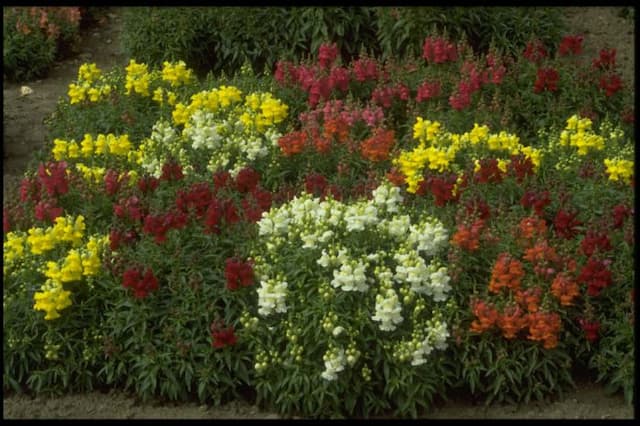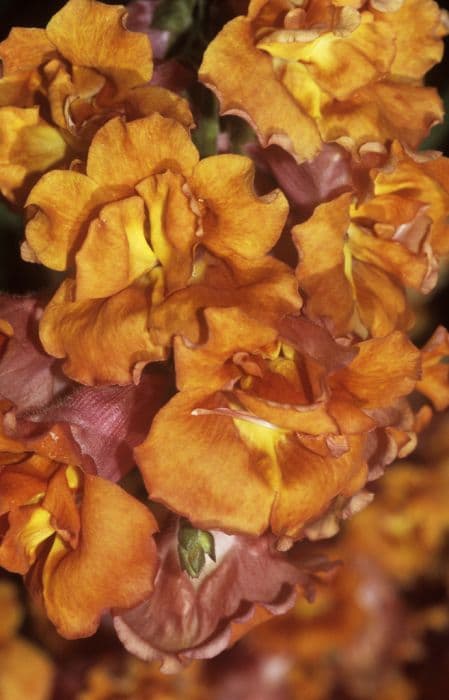Foxglove Digitalis × valinii Illumination Ruby Slippers = 'Tmdg1204' (PBR) (Illumination Series)
![foxglove [Illumination Ruby Slippers]](/_next/image?url=https%3A%2F%2Fplants-admin.emdemapps.com%2Fimages%2Fplants%2F%2Fimages%2F604b5cbc93f0b.png&w=3840&q=75)
ABOUT
The Foxglove Illumination Ruby Slippers is a striking plant with a unique and vibrant appearance. The blooms are particularly showy, featuring a blend of deep pink to ruby red petals, which are often accentuated with a gracefully speckled throat, showcasing shades of cream and yellow within. These tubular flowers are densely packed along tall, one-sided spikes, forming an impressive display that can be a centerpiece in any garden. The plant itself has a lush, bushy habit, with dark green foliage that provides a perfect backdrop for the vivid flowers. The leaves are oval to oblong, with a slightly toothed edge, lending a textured look to the plant's form. As part of the Illumination Series, Ruby Slippers boasts a prolific flowering season, with the potential to rebloom and extend the enjoyment of its exquisite blossoms. This hybrid variety stands out for its bold coloration, and when in full bloom, it is a magnet for pollinators like bees and hummingbirds, adding not just visual delight but also contributing to the garden's ecosystem.
About this plant
 Names
NamesFamily
Plantaginaceae
Synonyms
Foxglove 'Ruby Slippers', Illumination Ruby Slippers Foxglove
Common names
Digitalis × valinii Illumination Ruby Slippers = 'Tmdg1204' (PBR) (Illumination Series)
 Toxicity
ToxicityTo humans
The plant commonly known as foxglove contains toxic compounds known as cardiac glycosides, which can cause severe poisoning if ingested. Symptoms of foxglove poisoning in humans can include nausea, vomiting, diarrhea, headache, abdominal pain, dizziness, confusion, weakness, changes in heart rate and rhythm, and possibly death if not treated promptly. Ingestion of any part of the foxglove plant should be considered a medical emergency.
To pets
The foxglove plant is toxic to pets, including dogs and cats. It contains cardiac glycosides that can lead to serious health issues if ingested. Symptoms of foxglove poisoning in pets may include vomiting, diarrhea, drooling, cardiac abnormalities, weakness, collapse, and possibly death. Ingesting any part of the foxglove can have severe consequences for pets, and immediate veterinary care is critical.
 Characteristics
CharacteristicsLife cycle
Perennials
Foliage type
Evergreen
Color of leaves
Green
Flower color
Pink
Height
2 feet [60 cm]
Spread
18 inches [45 cm]
Plant type
Herb
Hardiness zones
5
Native area
Hybrid
Benefits
 General Benefits
General Benefits- Attractive Flowers: Digitalis × valinii 'Tmdg1204' produces vibrant ruby slipper-colored blooms that add eye-catching appeal to gardens and landscapes.
- Long Flowering Period: This plant typically has a long blooming season, offering a display of flowers from late spring through summer.
- Pollinator-Friendly: The flowers are attractive to bees, hummingbirds, and other pollinators, thus supporting biodiversity.
- Shade Tolerance: It can tolerate partial shade, making it suitable for planting under trees or in areas with varying light conditions.
- Low Maintenance: Once established, this plant requires minimal care, making it a good choice for gardeners of all skill levels.
- Perennial Growth: Being a perennial, it can live for several years, reducing the need for frequent replanting.
- Compact Size: Its compact growth habit makes it suitable for small gardens, borders, and containers.
 Medical Properties
Medical PropertiesThis plant is not used for medical purposes.
 Air-purifying Qualities
Air-purifying QualitiesThis plant is not specifically known for air purifying qualities.
 Other Uses
Other Uses- As a natural dye: The flowers of Digitalis, commonly known as foxglove, can be used to create a range of pink and purple dyes for textiles.
- Crafting botanical prints: The distinctive flowers and leaves can be used in creating detailed botanical prints on paper or fabric through a variety of techniques such as hammering or eco-printing.
- Photography subject: The striking appearance of foxglove makes it an excellent subject for photographers specializing in garden and plant photography.
- Floral art: Foxglove blooms can be incorporated into floral art pieces, such as living walls or sculptures.
- Educational tool: Foxglove can be used in educational settings to teach about plant biology, hybridization, and the ecology of bees for which its flowers are a rich source of nectar.
- Garden design: Foxglove can add height and color contrast in garden designs, particularly in cottage-style or perennial borders.
- Container gardening: Dwarf varieties can be suitable for container gardening, adding a vertical element to patios or balconies.
- Thematic gardening: Foxgloves can be used in thematic gardens, such as fairy or fantasy gardens, due to their whimsical appearance and association with folklore.
- Landscape restoration: Where appropriate, foxglove can be incorporated into wildflower mixes for habitat restoration and to support pollinator populations.
- Creative writing inspiration: The unique look and history of foxglove can serve as inspiration for creative writing, such as poetry or fantasy novels.
Interesting Facts
 Feng Shui
Feng ShuiThe plant Digitalis is not used in Feng Shui practice.
 Zodiac Sign Compitability
Zodiac Sign CompitabilityThe plant Digitalis is not used in astrology practice.
 Plant Symbolism
Plant Symbolism- Healing: Digitalis, commonly known as Foxglove, has been used in traditional medicine for its cardiac glycosides, which can treat heart conditions when properly administered.
- Care: As Foxgloves are potent both as a medicine and a poison, they symbolize the need for care in the application of power or strength.
- Inspiration: The vivid colors and stately growth of Foxgloves can represent creativity and inspiration, reminding us of nature's ability to evoke wonder.
- Magic: In folklore, Foxgloves are often associated with fairies and magic, their bell-shaped flowers providing the perfect hiding spot for mystical creatures.
- Stateliness: The tall and upright form of the Foxglove symbolizes stateliness and commanding presence, as it rises confidently above other plants in the garden.
 Water
WaterFoxgloves, including the Illumination Ruby Slippers, should be watered regularly to maintain moist but not waterlogged soil, particularly during their growing season in spring and summer. Aim to water deeply once or twice a week, allowing the water to penetrate several inches into the soil. The exact amount can vary depending on climate conditions, but a good rule of thumb is to provide about one gallon per plant each time you water, adjusting as necessary for rainfall and temperature. During hot, dry periods, additional water may be needed. In the winter, reduce watering to prevent rot, as the plant requires less moisture during dormancy.
 Light
LightFoxgloves prefer partial shade to full sun, thriving best with morning sunlight and afternoon shade. The optimal location would be an east- or north-facing garden that receives bright but indirect light for most of the day. Avoid placing them in deep shade or where they will be exposed to the harsh afternoon sun in hot climates, as this can stress the plants.
 Temperature
TemperatureFoxgloves, including the Illumination Ruby Slippers variety, perform well in a range of temperatures but prefer cooler conditions. They can tolerate minimum temperatures down to about 40 degrees Fahrenheit and maximum temperatures up to 85 degrees Fahrenheit. The ideal temperature range for these plants is between 60 and 70 degrees Fahrenheit, which supports robust growth and flowering.
 Pruning
PruningPruning foxgloves like Illumination Ruby Slippers is essential for maintaining plant health and encouraging more blooms. Deadheading, or removing spent flowers, should be done regularly to promote a second flush of blooms. After flowering, cut back the flower stalks to ground level to tidy up the plant and encourage it to put energy into root and foliage growth rather than seed production. The best time for pruning is immediately after the main blooming period.
 Cleaning
CleaningAs needed
 Soil
SoilThe best soil mix for the Foxglove 'Illumination Ruby Slippers' is a well-draining, loamy or sandy soil that is rich in organic matter. The soil pH should be slightly acidic to neutral, around 5.5 to 7.0, for optimal growth.
 Repotting
RepottingFoxglove 'Illumination Ruby Slippers' should be repotted every 1-2 years in the spring to refresh the soil and accommodate root growth, ensuring the plant remains healthy.
 Humidity & Misting
Humidity & MistingFoxglove 'Illumination Ruby Slippers' thrives in average humidity levels and does not require special humidity considerations as long as it's grown in outdoor garden conditions.
 Suitable locations
Suitable locationsIndoor
Place in bright, indirect light and water moderately.
Outdoor
Choose part shade, shelter from strong winds, and keep soil moist.
Hardiness zone
5-9 USDA
 Life cycle
Life cycleThe Digitalis × valinii 'Illumination Ruby Slippers' begins its life cycle as a seed that germinates in moist, well-drained soil, typically in spring under appropriate temperatures and light conditions. As the seedling emerges, it develops into a rosette of leaves and continues to grow, building a strong root system. In its first year, the plant focuses on vegetative growth, establishing a substantial clump of foliage. By the second year, it transitions from a vegetative stage to reproductive maturity, producing tall spikes adorned with spectacular tubular flowers ranging in color from pink to red, which are particularly attractive to pollinators such as bees and hummingbirds. Once pollination occurs, the flowers develop into seed capsules containing numerous tiny seeds, which can be dispersed to propagate new plants. After flowering, the plant may begin to decline; however, 'Illumination Ruby Slippers' is a perennial hybrid and can regenerate the following season from the existing rootstock or self-sown seeds.
 Propogation
PropogationPropogation time
Spring to Summer
The most popular method of propagating Foxglove Illumination Ruby Slippers, a patented hybrid, is through division. The best time to divide this plant is in early spring before new growth starts or in late fall after the plant has finished flowering. To propagate by division, carefully dig up the entire plant, making sure to keep the root ball intact. Then, using a sharp shovel or knife, divide the root ball into smaller sections, each with several shoots and a healthy amount of roots. These divisions can then be immediately replanted into prepared soil, ensuring that each divided section is placed at the same depth it was originally growing. Water the new divisions thoroughly to help establish them. It's important to note that patented plants like Foxglove Illumination Ruby Slippers are often subject to propagation restrictions, and unauthorized propagation may infringe on the patent holder's rights.


![Hebe [Garden Beauty Purple]](/_next/image?url=https%3A%2F%2Fplants-admin.emdemapps.com%2Fimages%2Fplants%2F%2Fimages%2F604b646a3d922.png&w=640&q=75)



![Penstemon [Phoenix Appleblossom]](/_next/image?url=https%3A%2F%2Fplants-admin.emdemapps.com%2Fimages%2Fplants%2F%2Fimages%2F604b553795aab.png&w=640&q=75)

